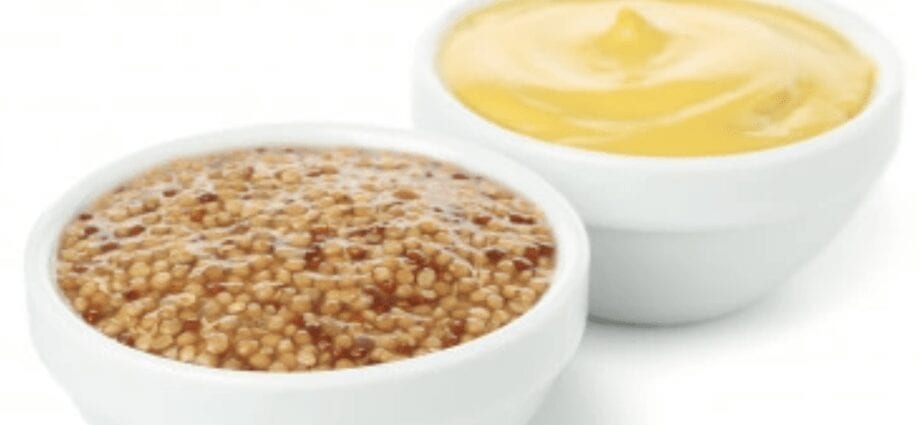Contents
Description
Mustard is a seasoning made from ground mustard seeds, water and vinegar. Has a pungent spicy taste. Mustard color ranges from pale yellow to olive yellow.
Mustard has been around for centuries. No wonder, because this plant has a huge number of beneficial properties, both in terms of culinary and medicinal value.
People who have mastered this culture are great fellows, because they were able to appreciate not only the excellent taste of the seasoning, but also the healing properties of the plant itself. Those original recipes have survived to this day in a slightly modified form, which does not in the least diminish the benefits of mustard.
History
Mustard is one of the oldest spices in the world, it was used in food both in Europe and in China. The historical homeland of mustard is usually called the Roman Empire.
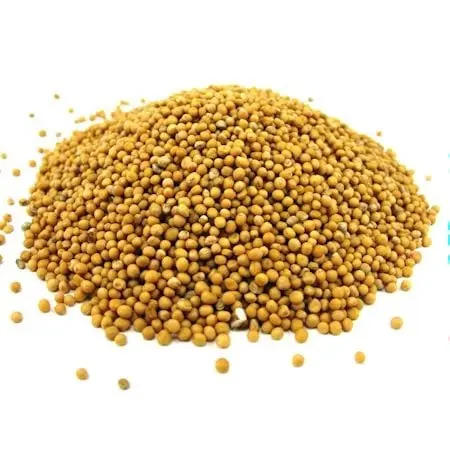
True, initially, instead of vinegar and water, grape juice was added to the crushed mustard. Some also used cumin, oregano, dill, coriander, honey and vegetable oil.
Hippocrates used mustard as a medicine, prepared from non-medicinal baths for colds and various viruses. Alexander the Great fed his soldiers with mustard so that they were “hot” in battle.
Mustard is also an integral part of European cuisine today. But the Germans and French prefer the less pungent mustard, which is practically sweet.
Chemical composition and calorie content
Quite a lot of mustard varieties are known, but their chemical composition and nutritional value are almost the same. Do not forget that all species have one ancestor, which means that the genetic code of all these plants is the same. Here is a list of the ingredients that make up our familiar seasoning:
- essential oil;
- proteins;
- carbohydrates;
- fats;
- alimentary fiber;
- starch;
- sugar;
- myronic acid (derivative in the form of a salt).
Mustard leaves, especially young ones, are rich in vitamins, the main of which belong to groups E and B. They also contain a decent amount of mineral salts.
The nutritional value of mustard directly depends on the form in which it is. If we are talking about a fresh plant that has not yet begun to wither, then the calorie content is 162 kcal per 100 grams of product. If the mustard is already cooked as a seasoning, then the value is lower – 67 kcal.
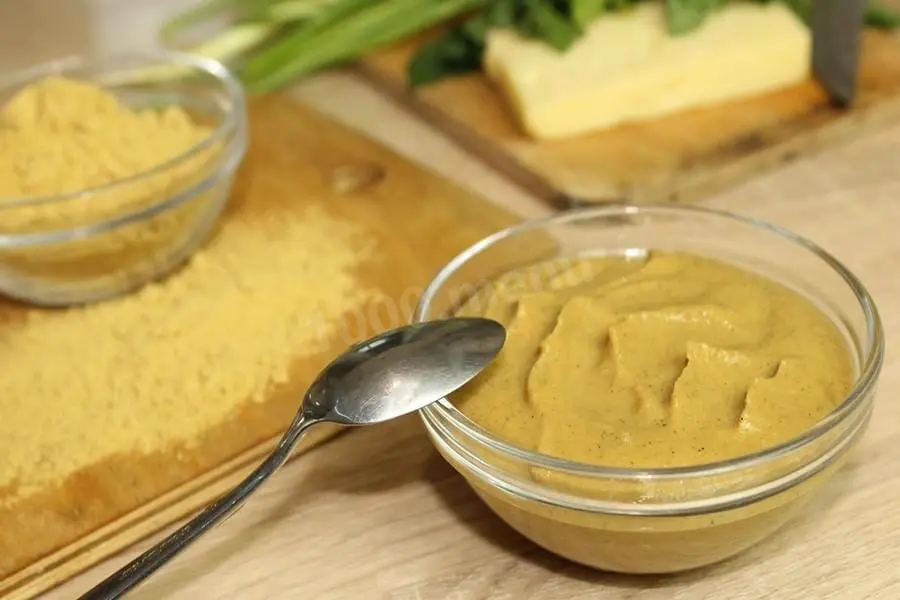
However, the plant acts as an auxiliary “dish”, so with its help it will still not be possible to satisfy the daily requirement for calories, proteins, fats, carbohydrates and vitamins.
Mustard types
Mustard has only three varieties. Humanity has long mastered the production and use of the following plant species:
White mustard. Despite the “telling” name, its color is yellow, very rich. People who are accustomed to hot spices may not like it – they can safely spread it on bread and eat it in the form of sandwiches.
Black (French). Even from the name one can understand its European origin. As mentioned above, the plant is quite thermophilic, so it grows best in Italy and in the southern provinces of France. It is from black mustard that the most famous and refined seasonings are made.
Sarepta (Russian). Other names are Chinese, brown, Indian. It grows well in the steppes of the Volga region and in Ukraine. Also, good harvests are harvested in Central Asia.
In terms of culinary qualities, it resembles the black variety, but has a more “vigorous” aroma. It is this mustard that is sold in stores as a yellow powder.
Brassica nigra Koch, Brassica alba Boiss, Brassica juncea Czern
This is where the natural varieties of mustard end. All other varieties are subspecies of these three main plants. It is from them that such famous seasonings as Dijon “cream”, fruit mustard and Creole delicacy are made.
Mustard benefits

Mustard is rich in proteins, organic acids, starch. Vitamins of group B, vitamins A, E, D have a beneficial effect on the body from the inside and outside. The same vitamin E is a powerful antioxidant, it prevents premature aging and is responsible for the elasticity and firmness of the skin.
Potassium, calcium, magnesium, zinc, phosphorus strengthen the cardiovascular and nervous systems. Mustard normalizes blood cholesterol levels, protects the body from free radicals.
For example, white mustard is especially useful for vascular sclerosis and liver and gallbladder diseases. Therefore, it is recommended for hypertensive patients.
Black mustard relieves pain in rheumatism. It is rich in potassium. Sarepta mustard is rich in carotene, ascorbic acid, calcium and iron. Helps with colds and inflammatory processes in the joints.
Mustard harm
Mustard can cause individual intolerance. In addition, the seasoning is contraindicated for people with gastritis, high acidity of the stomach, ulcers, and duodenal disease.
Caution is also needed for those who have been diagnosed with kidney disease or have a suspicion of pneumonia.
Mustard is healthy in small amounts. If you eat a lot of it, then there is irritation of the mucous membranes, the walls of the stomach and the digestive tract.
The use of mustard in medicine
The essential oils contained in mustard stimulate digestion, warm up well and accelerate blood flow. They have a warming, bactericidal effect.
Mustard is an excellent antioxidant. It contains vitamin C, beta-carotene, which support immunity, protect against negative environmental influences, and support the visual functions of our body (especially twilight vision).
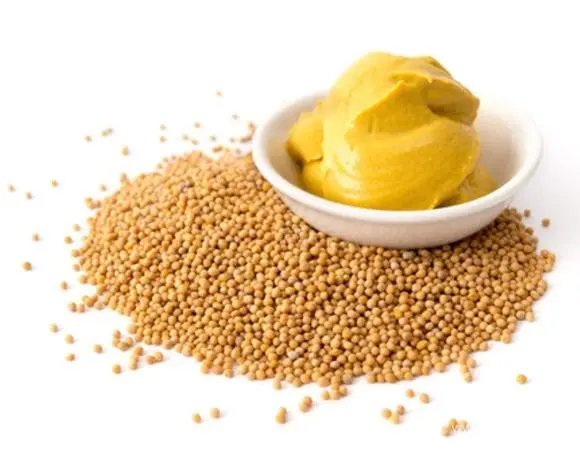
Mustard contains omega-3 and omega-6, linoleic acid. They protect against the development of atherosclerosis, strengthen the cardiovascular system. Suppress putrefactive microflora. It is useful for people suffering from flatulence, and for those who poorly absorb heavy food. Mustard breaks down protein and aids digestion.
Chromium is a trace mineral that helps insulin move glucose into cells. Prevents insulin resistance, which is one of the causes of excess weight. Mustard also has contraindications. In Europe, mustard is poured with cold water and it becomes sweet. It is softer and has fewer contraindications.
It is more burning. She has more contraindications. It has a clear irritating effect: gastritis, colitis, ulcers, kidney problems. The daily norm for a healthy person is one or two teaspoons, so as not to cause exacerbations
Cooking applications
Spicy mustard is used in chicken, turkey, veal and fish. Its main property during heat treatment is that it prevents the flow of meat juice. At the same time, it makes the dish spicy and the taste rich.
Also, mustard is used as an independent seasoning with bread, sausages and sausages. The seasoning is added to various sauces and marinades.
In cosmetology
Skin and hair – these are the main areas of application of mustard by women of fashion, and by other people who want to look young and beautiful. The plant is distinguished by its “irritating” property, due to which the formation of new hair follicles is stimulated.
Thus, mustard slows down baldness, and in some cases allows you to restore hair. The mustard powder wrap eliminates acne and irritation, in addition, it helps to normalize the fat balance.
Hair mask contains:
- two tablespoons of powder;
- one egg yolk (raw);
- two teaspoons of sugar.
- All components are mixed, the resulting “gruel” is evenly distributed throughout the hair. The mask should be kept for no more than 40 minutes.
Mustard mask to strengthen and grow hair
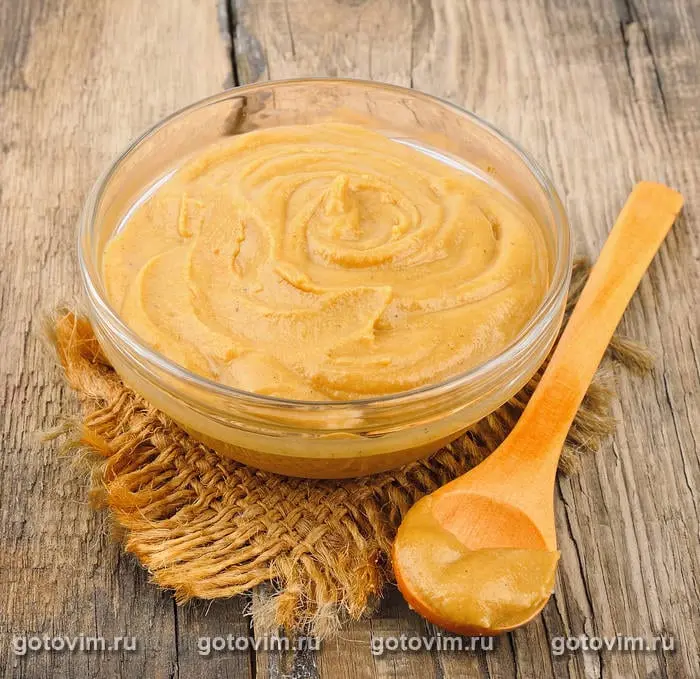
The face mask contains:
- 5 tablespoons of mustard powder;
- 10 ml lemon juice;
- 2 ml jojoba oil.
- The mixture is applied to clean skin, after 7 minutes it is washed off with plenty of water.
Mustard in everyday life
Mustard is known for its ability to dissolve almost any stain and break down fats. This property is used by housewives in dishwashing and laundry. It goes without saying that mustard powder should be used, not a tasty seasoning. It is added directly to the drum of the washing machine, sprinkling it on dirty laundry (50 grams will be required).
Hand wash requires 30 grams of powder per liter of water. The solution must be infused for 3 hours, after which things are rinsed in it. Mustard also absorbs unpleasant odors well. If you put the yellow powder in a cupboard (wrapped in a rag), then the “aroma” of mustiness and dampness will go away on its own, and quickly.
Agriculture
Mustard is pungent and has antibacterial properties. Some insects are afraid of her. It is not surprising that in the “dacha and vegetable garden” sphere it is used for pest control. It is permissible to use only seeds that are buried in the ground. In addition to antiseptic properties, they have the ability to accumulate nitrogen, which is very useful for the root system of cultivated plants.
How to choose quality mustard and where to buy it
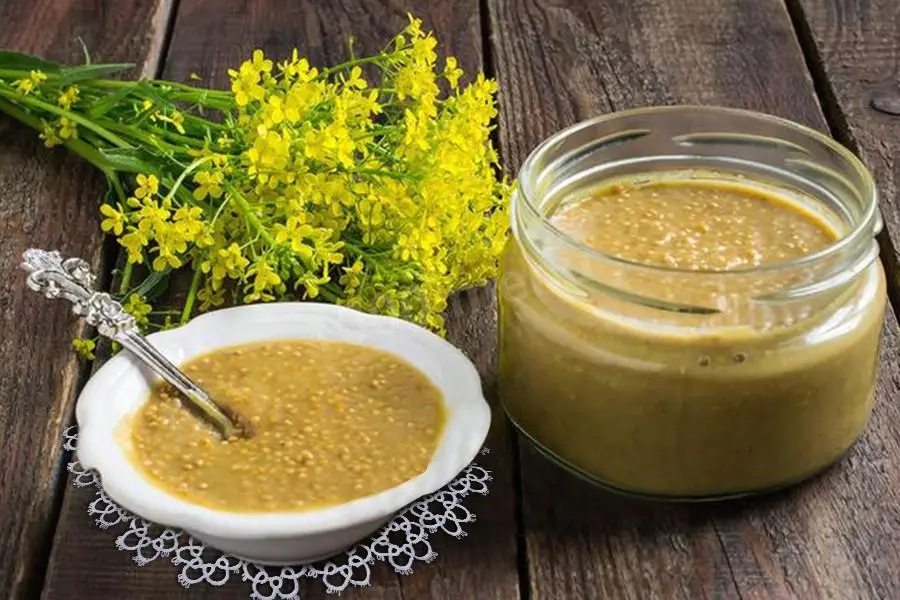
You can buy a good product anywhere. Sometimes in large supermarkets they sell a frank surrogate, and in the markets they sell an excellent seasoning. You need to look not at the place of purchase, but at the appearance of the mustard, its packaging and composition indicated on the label. The fewer ingredients the better. Even the vinegar from the recipe described above is poorly suited to industrial mustard. So discard:
- mustard sauces;
- seasonings in bags and plastic bags;
- product sold by weight.
It is recommended to buy only the mustard that is packed in sealed glass jars. But even in this case, look at the expiration date – an expired seasoning, even if it does not lead to poisoning, will spoil the taste of the food for sure.
Growing mustard at home
For middle latitudes, Russian mustard (Sarepta) is optimal. It takes root well in all types of soil, withstands sudden temperature changes. The only limitation is that the plant does not like very moist soil, so wetlands are not suitable for mustard.
The greenhouse can only be used in spring, immediately after planting. The fact is that the optimal temperature for growing is 18 degrees, if it is warmer, then the leaves of our crop will quickly become coarse.
For mustard, a separate bed should be allocated, which is best sown in mid-March if a greenhouse is used, or in mid-April in open ground. The distance between the seeds must be kept about 22 centimeters, and they should be planted to a depth of 1.5 cm.
No heavy watering – water immediately after planting and keep watering a little every 2-3 days. The first seedlings will be ready for harvest in 15-20 days, depending on the weather. These showers are great in a salad, try it, you won’t regret it!
Chicken with mustard

Poultry meat is juicy and spicy in taste. The mustard and many spices give the chicken a sweet and tangy flavor. Almost all ingredients are used by eye, so it depends on the chef how much pepper, honey or mustard to add. Chicken can be served with potatoes, vegetables or salads.
- Chicken – 1 piece
- Salt to taste
- Ground black pepper – to taste
- Ground cinnamon – to taste
- Mustard – to taste
- Honey – to taste
Rinse and dry the chicken thoroughly. Mix honey, mustard, salt and pepper separately in a bowl. Grate the inside and outside of the chicken with this mixture. Hide the remains in the resulting pockets. Wrap the chicken in foil and bake for 30-40 minutes in the oven at 180 degrees.










